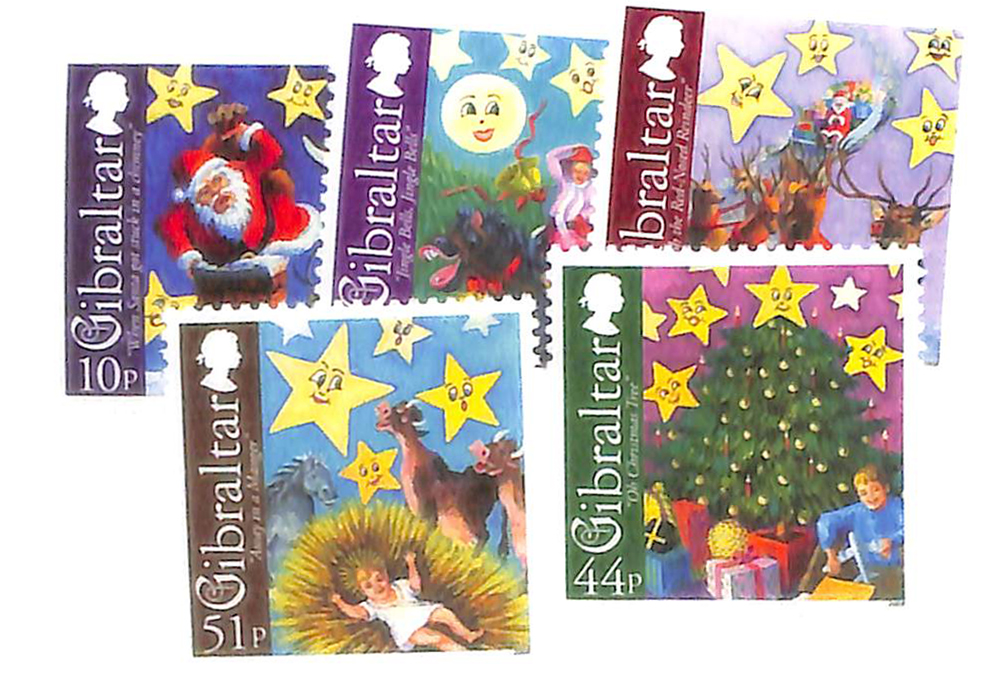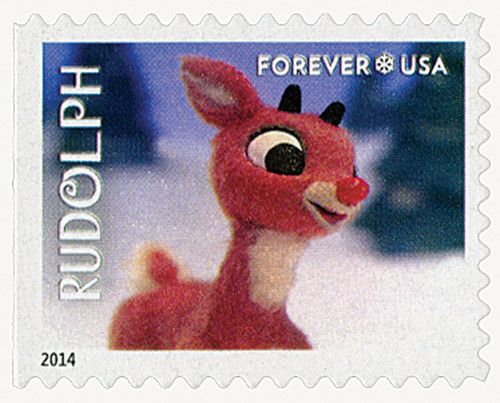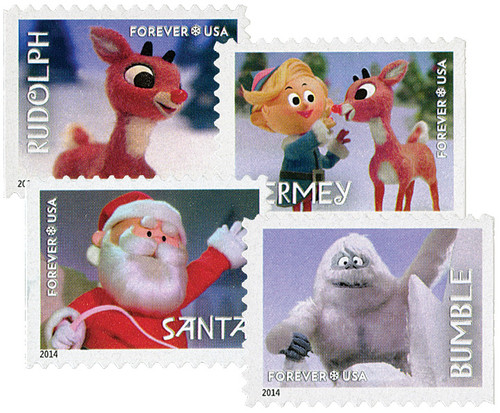
# 4949a - 2014 49c Rudolph the Red-Nosed Reindeer, block of 4 stamps
U.S. #4949a
2014 49¢ Rudolph, the Red-Nosed Reindeer
Block of 4
In 1939, a copywriter for Montgomery Ward created a children’s book as a Christmas promotion. Rudolph the Red-Nosed Reindeer was a hit, spinning off a song of the same name that became a holiday classic. Twenty-five years later, Rudolph’s tale was turned into a television special. It has been shown annually since 1964, making Rudolph the Red-Nosed Reindeer the longest-running Christmas television special in history.
Rudolph The Red-Nosed Reindeer
In the 1930s, Chicago-based retail store Montgomery Ward bought and gave away coloring books to children every year for Christmas. In 1939, they decided it would be easier to create their own book and tasked copywriter Robert May with crafting a fun story for their new book.
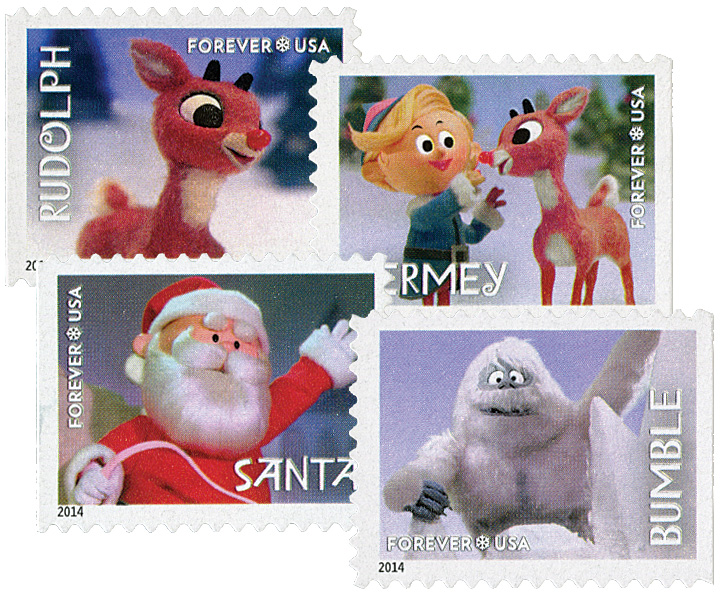
May knew the story would be about a reindeer and first considered naming it Rollo or Reginald before deciding on Rudolph. While sitting in his office considering how to write the story, he looked out the window to see a thick fog rolling in over Lake Michigan. As he later recalled, “Suddenly I had it!… A nose! A bright red nose that would shine through the fog like a spotlight!”
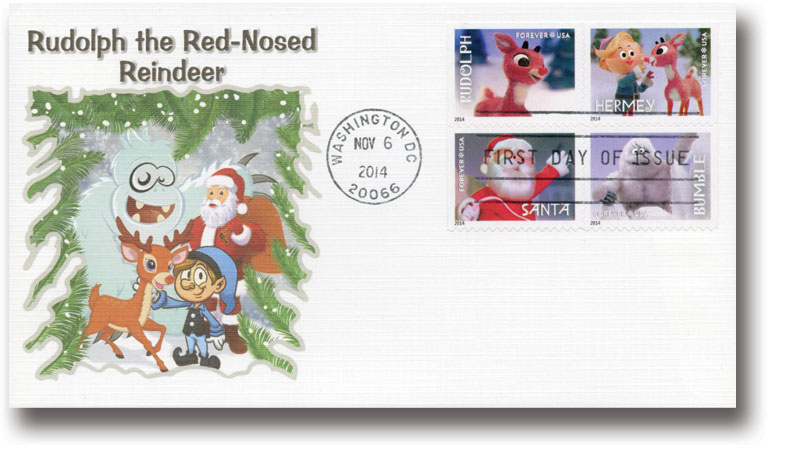
May consulted often with his four-year-old daughter Barbara as he composed the tale, changing the story to please her. He designed the story as a poem, matching the popular “A Visit from St. Nicholas.”
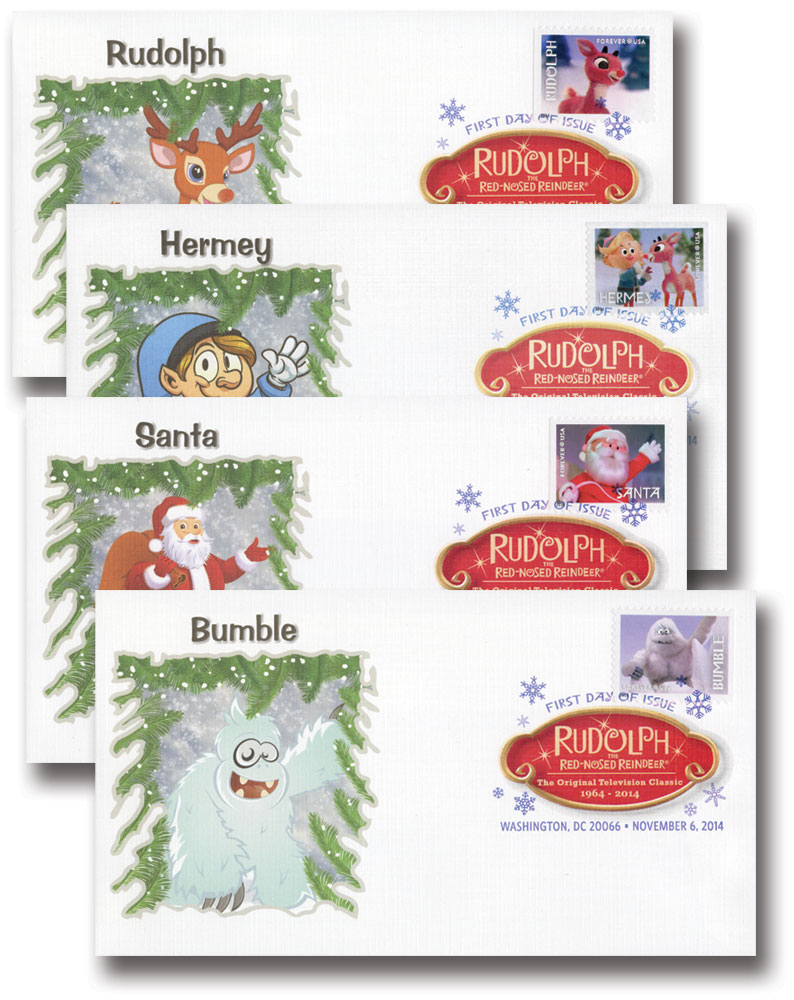
When shown the finished story, May’s employer asked, “Can’t you come up with anything better?” But the executive agreed to publish May’s fable of an adventurous reindeer, and customers snatched up 2.4 million copies in that first year.
Nearly a decade later, the story was turned into a cartoon by Max Fleisher to promote Montgomery Ward stores. Then in 1949, May’s brother-in-law turned the poem into a song, popularly performed by Gene Autry. The tune, which differed some from the book, was the number one song that Christmas and sold 2.5 million copies its first year. It would go on to become the second best-selling record of all time into the 1980s. In the coming years, the tale of Rudolph would also be adapted for comic books as well as another children’s book from Little Golden Books.
In 1964, 25 years after the original book was produced, the story was adapted once again, into the beloved stop-motion animation television special by Rankin and Bass. When the producers were planning the special, they couldn’t find a copy of the book, so they based their story on the song and added in some new characters – Hermey the elf, Yukon Cornelius, Clarice, the Abominable Snow Monster, and Sam the living Snowman.
U.S. #4949a
2014 49¢ Rudolph, the Red-Nosed Reindeer
Block of 4
In 1939, a copywriter for Montgomery Ward created a children’s book as a Christmas promotion. Rudolph the Red-Nosed Reindeer was a hit, spinning off a song of the same name that became a holiday classic. Twenty-five years later, Rudolph’s tale was turned into a television special. It has been shown annually since 1964, making Rudolph the Red-Nosed Reindeer the longest-running Christmas television special in history.
Rudolph The Red-Nosed Reindeer
In the 1930s, Chicago-based retail store Montgomery Ward bought and gave away coloring books to children every year for Christmas. In 1939, they decided it would be easier to create their own book and tasked copywriter Robert May with crafting a fun story for their new book.

May knew the story would be about a reindeer and first considered naming it Rollo or Reginald before deciding on Rudolph. While sitting in his office considering how to write the story, he looked out the window to see a thick fog rolling in over Lake Michigan. As he later recalled, “Suddenly I had it!… A nose! A bright red nose that would shine through the fog like a spotlight!”

May consulted often with his four-year-old daughter Barbara as he composed the tale, changing the story to please her. He designed the story as a poem, matching the popular “A Visit from St. Nicholas.”

When shown the finished story, May’s employer asked, “Can’t you come up with anything better?” But the executive agreed to publish May’s fable of an adventurous reindeer, and customers snatched up 2.4 million copies in that first year.
Nearly a decade later, the story was turned into a cartoon by Max Fleisher to promote Montgomery Ward stores. Then in 1949, May’s brother-in-law turned the poem into a song, popularly performed by Gene Autry. The tune, which differed some from the book, was the number one song that Christmas and sold 2.5 million copies its first year. It would go on to become the second best-selling record of all time into the 1980s. In the coming years, the tale of Rudolph would also be adapted for comic books as well as another children’s book from Little Golden Books.
In 1964, 25 years after the original book was produced, the story was adapted once again, into the beloved stop-motion animation television special by Rankin and Bass. When the producers were planning the special, they couldn’t find a copy of the book, so they based their story on the song and added in some new characters – Hermey the elf, Yukon Cornelius, Clarice, the Abominable Snow Monster, and Sam the living Snowman.






